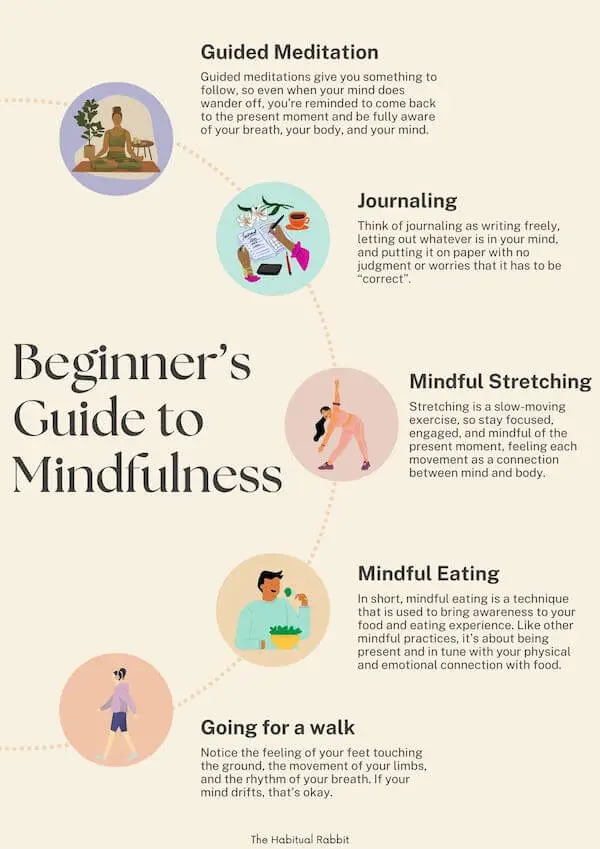
Distraction is all around us. Nowadays, it’s so easy to get lost in the chaos that is our lives. With a never-ending to-do list, a jam-packed schedule, and going from one thing to the next, it’s no wonder our body has to run on autopilot. There are so many things you need to do but just simply not enough time to do it all!
I get it, I’ve been there.
As a busybody myself, it’s hard to find “me” time. On top of that, my thoughts NEVER turn off. When I say never, I really mean never. Like 2:00am, my mind still running rampant, keeping me awake. And with so many things to do, I rarely have time for myself. I also tend to prioritize everything else above my own needs, always pushing myself to the limit, which really started to take a toll, eventually resulting in me having multiple breakdowns a week.
Until I started practicing mindfulness.
If you haven’t read my previous article sharing my personal experience with depression and anxiety, then I highly suggest you start there because I go into detail about how practicing mindfulness really saved my life.
Mindfulness is the art of paying attention to the present moment without judgment. It’s about cultivating a state of awareness that allows us to fully engage with our experiences, thoughts, and emotions. By practicing mindfulness, we can tap into a treasure trove of benefits for our overall well-being.
Here’s the best way I can describe what practicing mindfulness feels like for me:
It’s like entering a realm where time is slowed down, where everything moves a little slower, where you feel a little calmer. It’s like finding a new friend within yourself. It’s like discovering who you really are and getting to know all the parts of you, all the stages of life, all the experiences that still live and breathe in you. Getting to know the parts of you that might be dictating your actions and behaviors without you even being aware of it; getting to know THOSE parts, the not-so-pretty parts, and gaining an understanding. By getting to know these parts of yourself, you start to understand, and when you understand, you can empathize. And once you can empathize with yourself, well, then you stop being so hard on yourself all the time.
At least that’s what it’s like for me.
“Yes, Jess. I get it, I need to practice mindfulness, but who has the time?! And where do I even begin?!”
We all have to start somewhere right?
Lucky for you, Kevin and I have created this Beginner’s Guide to help you start on your mindfulness journey. Like you, we had no idea where to start. In fact, we thought it was quite silly at first. It took a TON of time and practice for us to really get into it and to actually see a real shift in our mindsets.
1. Guided meditation
I like to start with a guided meditation because, well, I didn’t really know how to start in silence with my own thoughts when I began this journey. My mind was always wandering off, so I opted for guided meditations. Thanks, YouTube!
The first step is understanding that mindfulness is all about being aware in the present moment. Guided meditations give you something to follow, so even when your mind does wander off, you’re reminded to come back to the present moment and be fully aware of your breath, your body, and your mind.
Many guided meditations will begin with mindful breathing, which I think is one of the simplest and most accessible mindfulness practices. Find a quiet spot, sit comfortably, and bring your attention to your breath. Notice the sensation of the breath as it enters and leaves your body. Whenever your mind wanders (and it will), gently guide your attention back to the breath. Start with just a few minutes and gradually increase the duration.
Body scans are also very effective in bringing your awareness to the present moment. Lie down or sit in a comfortable position. Close your eyes and bring your attention to different parts of your body, starting from the top of your head and moving down to your toes. Notice any sensations, tensions, or areas of relaxation. The key is to observe without judgment or the need to change anything.
Remember to try different methods and see what works best for you. I find that when it comes to guided meditation, a voice and style that resonates most with me is often most effective in helping me enter a mindful state.
2. Journaling
This one is my favorite. It does require more effort because more often than not, writing is a lot of mental work. But mindful journaling doesn’t have to be. I like to think of journaling as writing freely, letting out whatever is in your mind, and putting it on paper with no judgment or worries that it has to be “correct”.
For me, journaling has always been therapeutic. It’s how I process information, it’s how I reflect on my thoughts and emotions and has provided me with an outlet to not only express myself but to better understand myself.
My number one rule for mindful journaling is this: Let go of errors.
Don’t worry about grammar, punctuation, spelling, or any of that.
The goal here is to just let all of your thoughts out, unfiltered. It’s like having a conversation with yourself, without judgment.
Here is an exercise that I often use: Imagine that there is an eraser that follows your pen, pencil, or keyboard – whatever you’re writing with. And every word you write will get erased, so there’s no need to worry about whether something is written correctly. And if you want to go back on it, then write that out. It’s like talking out loud, right? Once you say something, you can’t take those words back. But you can adjust with whatever you say next. And don’t worry about it sounding like one big, confusing mess; our mind is a mess, that’s why we do this exercise.
Pro Tip: Set a timer for how long you want to do this and stick with it. Like other practices, consistency is key!
3. Mindful stretching
This actually started when I developed neck and back pain. My chiropractor told me I needed to stretch more, twice a day to be exact, and he gave me exercises to do at home. Because it’s in my antsy nature to do things quickly, stretching and yoga were things I really struggled with because I hated anything that was slow.
But I did it anyway and forced my mind to slow down with my body, and after a week of stretching twice a day, every day, it actually started to feel nice. I felt calmer, more relaxed, and my body felt significantly better.
Even though stretching is a slow-moving exercise, I tried to stay focused, engaged, and mindful of the present moment, feeling each movement as a connection between my mind and my body.

4. Mindful eating
This was a tough one to adapt to. Before, I liked to watch TV or look at my phone while I ate if I was eating alone. It was sort of my time to catch up on shows, scroll through social media, and see what was going on in the world. Something to do while I get through my meal. I also ate REALLY fast, which is not great for my digestive system.
So when I started to practice mindful eating, it felt super strange.
In short, mindful eating is a technique that is used to bring awareness to your food and eating experience. Like other mindful practices, it’s about being present and in tune with your physical and emotional connection with food. Mindful eating involves:
- Appreciating your food (great gratitude practice!)
- Eating without distractions – it’s just you and your food
- Eating slowly (this was hard for me)
- Listening to your body and stopping when you’re full (don’t overeat)
- Noticing the colors, smells, flavors, and textures of your food
- Being aware of any guilt or anxiety you might have around food
- Noticing the effects on your feelings and body
I’ll admit, I don’t do this all the time for every meal, but I do try to incorporate it into my day at least once. And to be honest, it feels kind of nice. My typical day is quite chaotic with a lot of stimulation, so allowing myself to have 15-20 minutes of silence to be present and enjoy my meal is something I’ve come to really value.

5. Going for a walk
This is a quick and easy one. I love being outside, so going for a walk is a simple way for me to enjoy the outdoors and practice mindfulness, all at once! It’s especially nice when the weather is warm and sunny so you can soak in some vitamin D!
You can start by taking a leisurely stroll and focusing your attention on the sensations in your body as you walk. Notice the feeling of your feet touching the ground, the movement of your limbs, and the rhythm of your breath. If your mind drifts, that’s okay. Just gently bring it back to the present moment and the act of walking.
That’s it!
Final Thoughts
Remember, practicing mindfulness is a journey, not a destination. It took Kevin and me a LONG time to get to where we are now, and the path wasn’t always forward. Be patient and kind with yourself as you explore these techniques and see what works best for you. Start with small steps and gradually integrate mindfulness into your daily life. With time, you’ll discover that the present moment is filled with wonders waiting to be savored. So take a deep breath, let go of distractions, and embark on this beautiful adventure of mindful living.
